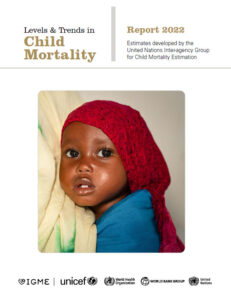
United Nations Inter-Agency Group for Child Mortality Estimation (UN IGME), Report 2022
In total, more than 5.0 million children under age 5, including 2.3 million newborns, along with 2.1 million children and youth aged 5 to 24 years – 43 per cent of whom are adolescents – died in 2021. This tragic and massive loss of life, most of which was due to preventable or treatable causes, is a stark reminder of the urgent need to end preventable deaths of children and young people. Sadly, these deaths were mostly preventable with widespread and effective interventions like improved care around the time of birth, vaccination, nutritional supplementation and water and sanitation programmes.
Timely, high-quality and disaggregated data – which allow the most vulnerable children to be identified – are critical to achieving the goal of ending preventable deaths of children. Yet as the COVID-19 pandemic has put into stark light, data of this nature are more the exception than the rule: Just 36 countries have high-quality nationally representative data on under-five mortality for 2021, while about half the world’s countries have no data on child mortality in the last five years. These substantial data gaps pose enormous challenges to policy- and decision-making and prolong the need for modelling mortality from what little data are available. To improve the availability, quality and timeliness of data for monitoring the health and survival situation of children and youth, much greater investments must be made to strengthen data systems.
Almost everywhere in the world, a child born today has a better chance at surviving to age 5 than in 1990, but inequities persist among and within countries
Globally, the under-five mortality rate (U5MR) fell to 38 deaths per 1,000 live births in 2021, while under-five deaths dropped to 5.0 million. This immense, intolerable and mostly preventable loss of life was carried unequally around the world however, and children continue to face widely differing chances of survival based on where they are born. In contrast to the global rate, children born in sub-Saharan Africa are subject to the highest risk of childhood death in the world with a 2021 U5MR of 74 deaths per 1,000 live births – 15 times higher than the risk for children in Europe and Northern America and 19 times higher than in the region of Australia and New Zealand
Children born in poorer countries are also more likely to die before reaching age 5. Children born in low-income countries, where the 2021 U5MR was 67 deaths per 1,000 live births, were 14 times more likely to die before reaching age 5 than children born in high-income countries, where the 2021 U5MR was just 5 deaths per 1,000 live births. At the country level, U5MRs in 2021 ranged from 2 deaths per 1,000 live births to 115 deaths per 1,000 live births, 67 times higher than in the lowest mortality country.
Divergent chances of survival start from the earliest ages
While the global neonatal mortality rate (NMR) in 2021 was 18 deaths per 1,000 live births, regionally, sub-Saharan Africa had the highest NMR in the world at 27 deaths per 1,000 live births: A child born in sub-Saharan Africa is 11 times more likely to die in the first month of life than a child born in the region of Australia and New Zealand, which has the lowest regional NMR in the world. Sub-Saharan Africa is followed by Central and Southern Asia at 22 deaths per 1,000 live births. The risk of death in the first month of life for a child born in a high-income country was one tenth the risk for a child born in a low-income country. At the country level, the risk of dying during the first 28 days of life for a child born in the highest mortality country was about 53 times higher than in the lowest-mortality country.